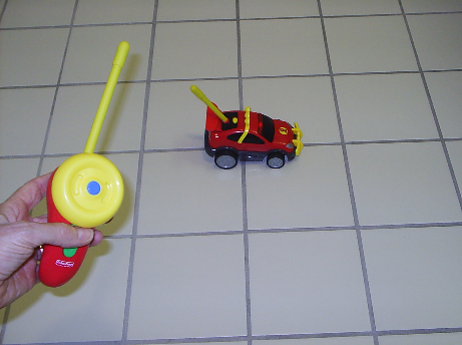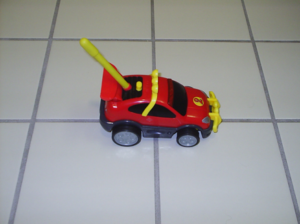Model Description:
This is a simple demonstration to distinguish among a particle’s coordinates, position, displacement, and total distance traveled. A remote-controlled car is used to demonstrate the distinctions, for a particle in rectilinear motion. This demonstration should take 5-8 minutes.

Engineering Principle:
The position (location) of a particle in rectilinear motion can be described by Cartesian coordinates. If the positive x-axis of a Cartesian (x-y-z) coordinate system is lined up with a particle’s direction of travel, the single coordinate x will suffice to locate the particle’s position. In scalar form, the particle is said to be located at position x, or, more completely, at (x,0,0). Coordinates can have positive or negative values. In vector form, the particle is located at xi+0j+0k , or simply xi. Any of these four expressions suffices to locate the particle; but the particle’s position should always be considered as a vector quantity, since it represents both a magnitude (distance) and a direction from the origin. The coordinates are the scalar quantities, which—with the coordinate system—describe the particle’s location. If the coordinate system is rotated clockwise through some angle θ (say, 35°), then two coordinates will now be necessary to describe the particle’s position: (x,y), (x,y,0), xi+yj , or xi+yj+0k. Again, the position is normally described relative to the coordinate system origin, and is a vector quantity.
The displacement of a particle describes its position relative to another (typically fixed) reference point, not necessarily the origin of the coordinate system. If the reference position is , the displacement at any point xi is the vector (x-x_1 )i , or simply x-x_1, with the unit vector understood (for rectilinear motion in the x direction). The position of the particle is simply its displacement from the origin.
The total distance traveled differs from the displacement in two significant ways:
1) The total distance traveled is a positive scalar; but the displacement is a vector, even if given in scalar form with the unit vector understood.
2) The total distance traveled from position 1 to position 2 represents the length of the actual path (taking into account any overlaps) traversed by the particle along the path it traveled; the displacement, on the other hand, simply represents the vector (even if given in scalar form as x) from position 1 to position 2, and gives no information about the path traveled. For example, the particle could have started and stopped at the same location, after traveling a significant distance. (In rectilinear motion, of course, this would entail the particle’s reversing direction at least once.) In this case the displacement would be a vector of magnitude zero; and the total distance traveled, some nonzero scalar.
What you Need:
| Item | Qty | Cost and Build Time | Description/Details |
| Model Car | 1 | $5-30 | Any small model will suffice (even a book or an eraser will do), but a rolling vehicle is preferred—and if it is remotely controllable it will be more memorable for the students. |
How it’s Done:
Before Class: Mark a coordinate system (with origin) on the floor (or desk) and practice the demonstration. Be sure to have the room arranged so that students can see the demonstration.
In Class: Move (or operate, if remotely controllable) the vehicle from the origin along the x axis (1) in a positive direction, (2) in a negative direction, and (3) along a path that includes motion in both positive and negative directions. Discuss how to locate the vehicle using the coordinate system. Discuss also the advantage of a coordinate system that has an axis aligned with the car’s motion, for rectilinear motion. Use marks or tiles on the floor to quantify coordinates, position, and displacement; note the coordinate signs and sign changes. Determine the total distance traveled for each of the three motions, noting that the total distance traveled is always nonnegative.
Observations: The students should observe that coordinates can be zero, positive, or negative; but that the total distance traveled is always nonnegative. They should note that for rectilinear motion whenever the vehicle reverses direction it passes through a condition of zero velocity. The times or locations of zero velocity may be needed for determining total distance traveled. Students should observe that, for motion only in the positive x direction, the total distance traveled and the x coordinate have the same value; but that for motion only in the negative x direction the total distance traveled and the coordinate do not have the same value. In particular, the former is the absolute value (magnitude) of the latter.
Wait, There’s More:
Rotate the coordinate system through some angle (between 30° and 60° , for visual clarity), and repeat the demonstration. (Alternatively, but less desirably, you could use the same coordinate system and rotate the “roadway.”) Note the increase in complexity of the mathematical description for the vehicle motion—even though the vehicle still has the same rectilinear motion—since now two coordinates are required instead of one. Remark on the desirability of choosing your coordinate system to simplify the mathematical description, where possible.

